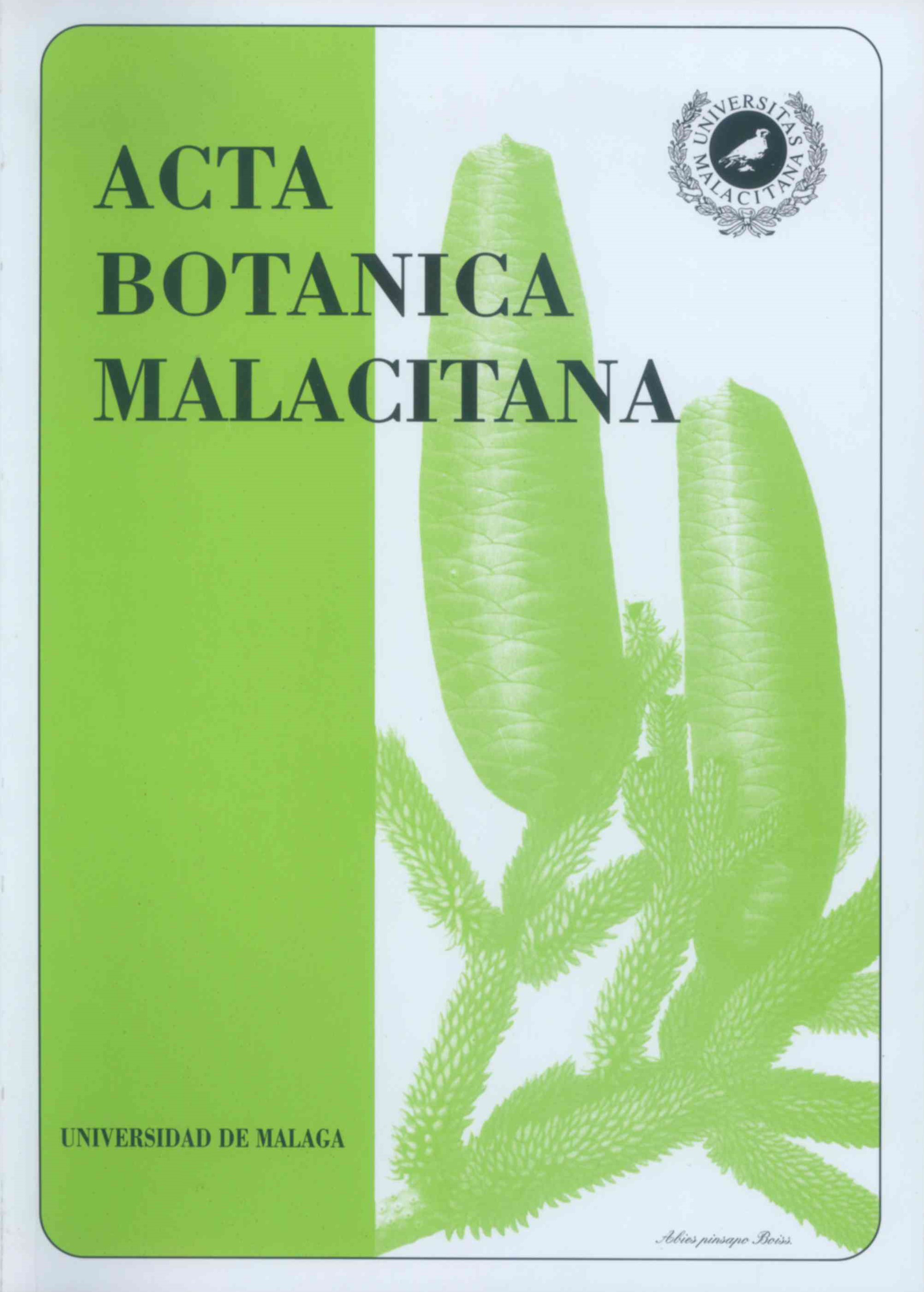El polen de Eucalyptus y su incidencia en la atmósfera de Vigo (N.O. España)
DOI :
https://doi.org/10.24310/abm.v26i0.7403Mots-clés :
Meteorología, Myrtaceae, Polen, Eucalyptus, VigoRésumé
Eucalyptus globulus Labill. es la especie arbórea de la familia Myrtaceae, más frecuente en los alrededores de la ciudad de Vigo formando abundantes y densas masas forestales. Aunque su polen se considera moderadamente alergénico, en áreas en las que, como consecuencia de repoblación forestal ocupa extensiones importantes, puede llegar a causar problemas alérgicos. Entre los años 1995 y 2000 se ha realizado el estudio aerobiológico en la ciudad de Vigo mediante un captador LANZONI VPPS 2000 situado en la margen derecha de la ría de Vigo (42°14'15"N, 8°43'30"W). La cantidad de granos de polen anual de Myrtaceae varía ampliamente, alternándose años de concentraciones bajas con otros de valores elevados que representan entre un 1 y un 3% del polen total anual. El valor más elevado se detectó en 1997 con 1.147 granos de polen. Se encuentra en la atmósfera de Vigo durante todo el año, aunque las concentraciones más importantes se producen generalmente durante los meses de marzo y abril. Asimismo, a lo largo del día los máximos de concentración tienen lugar entre las 15 y las 17 horas. Finalmente se ha realizado un análisis estadístico para poner de manifiesto la posible correlación existente entre las concentraciones de polen y los principales parámetros meteorológicos. El viento procedente del N-NE fue el parámetro con el que se obtuvo correlación positiva y significativa de forma constante, mientras que esta fue negativa con la humedad relativa.
Téléchargements
Métriques
Références
AIRA M.J., A. DOPAZO y A. ARGIBAY -1999- Aeropalinología en Galicia: Estación de Santiago de Compostela (1998). Rea 5: 119-112.
ANDERSEN, T. -1991- A model to predict the beginning of the pollen season. Grana 30: 269-275.
ANDERSEN, S. Th. -1980- Influence of climatic variation on pollen season severity in wind- Pollinated trees and herbs. Grana 19: 47-52.
ARENAS, L., C. GONZÁLEZ, J.M. TABARÉS, I. IGLESIAS, M.V. JATO y J. MÉNDEZ -1996- Sensibilización cutánea a pólenes en pacientes afectos de rinoconjuntivitis-asma en la población de Ourense en el año 1994-1995. Proceedings of the Pi European Symposio on Aerobiology, CA'96. Santiago.
BELMONTE, J., J.M. ROURE & X. MARCH - 1998- Aerobiology of Vigo, North-Western Spain: Atmospheric pollen spectrum and annual dynamics of the most important taxa, and their clinical importance for allergy. Aerobiologia 14: 155-162.
BELMONTE, J., M. VENDRELL y J.M. ROURE - 1999- Aerobiología en Cataluña: estación de Barcelona (1999). Rea 5: 79-82.
BERMÚDEZ, J. y M. TOUZA -2000- Las cifras del tercer inventario forestal en Galicia y su incidencia en la industria de la transformación de la madera. Cis-Madera 2000, 4: 6-24.
CARBALLEIRA, A., C. DEVESA, R. RETUERTO, E. SANTILLÁN y E. UCIEDA -1983- Bioclimatologia de Galicia. Fund. Bardé de la Maza, La Coruña: 391.
DAHL, A. & STRANDHEDE, S. -1996- Predicting the intensity of the birch pollen season. Aerobiología, 12: 97-106.
DE LA LAMA, G. -1978- Atlas del eucalipto. Instituto Nacional de investigaciones Agrarias, Ministerio de Agricultura (TOMO V). Madrid.
DOMÍNGUEZ, E., J.L. UBERA y C. GALÁN - 1984- Polen alergógeno de Córdoba. Publicaciones del Monte de Piedad y Caja de Ahorros de Ronda. Córdoba.
DOMÍNGUEZ, E., C. GALÁN, F.E. VILLAMANDOS & F. INFANTE -1992- Handling and evaluation of the data from the aerobiological sampling. Monografías Rea-Ean 1: 1-18.
EL-GHAZALY, G., P. EL-GHAZALY, K. LARSSON & S. NILSON -1993- Comparison of airborne pollen grains in Huddinge and Stockholm, Sweden. Aerobiologia 9: 53-67.
EMBERLIN, J., M. SAVAGE & R. WOODMAN - 1993- Annual variations in the concentrations of Betula pollen in the London area, 1961-1990. Grana, 29: 301-309.
GALÁN, C., R. TORMO, J. CUEVAS, F. INFANTE & E. DOMÍNGUEZ -1991- Theoretical daily variation patterns of airborne pollen in the South-west of Spain. Grana 30: 201-209.
GÓNZALEZ, F.J., J. MORALES, P. CANDAU, C. TOMÁS y A.M. PÉREZ TELLO -1999- Aerobiología en Andalucía: estación de Sevilla (1998). Rea 4: 49-52.
HIRST, J.M. -1952-An automatic volumetric sporetrap. Ann. App!. Biol. 36: 257-265.
JAGER, S., F.TH. SPIEKSMA & N. NOLARD - 1991- Fluctuations and trends in airborne concentrations of some abundant pollen types, monitored at Vienna, Leiden and Brussels. Grana 30: 309-312.
LATORRE, F. -1999- Differences between airborne pollen and flowering phenology of urban trees with reference to production, dispersal and interannual climate variability. Aerobiologia 15: 131-141.
LEWIS, W.H., P. V1NAY & V.E. ZENGER -1983- Airborne and allergenic pollen of North America. The Johns Hopkins Univers. Press. 254. Baltimore.
NILSSON, S. & S. PERSSON -1981- Tree pollen spectra in the Stockholm region (Sweden), 1973- 1980. Grana 20: 179-182.
RECIO, M. -1995- Análisis polínico de la atmósfera de Málaga (1991-1994). Relación con los parámetros meteorológicos. Tesis Doctoral. Universidad de Málaga.
RODRÍGUEZ-RAJO, Fi. -2000- El polen como fuente de contaminación ambiental en la ciudad de Vigo. Tesis Doctoral. Universidad de Vigo.
SP1EKSMA, F. TH., N. NOLARD, G. FRENGUELLI & D. VAN MOERBEKE -1993- Polen atmosférico en Europa. UCB, Bruselas.
SPIEKSMA, F. TH., J.C. EMBERLIN, M. HJELMROOS, S. JAGER & R.M. LEUSCHNER -1995- Atmospheric birch (Bctula) pollen in Europe: Trends and fluctuations in annual quantities and the starting dates of the seasons. Grana 34: 51-57.
SUBIZA, J., JEREZ, M., JIMÉNEZ, JA., NARGANES, J.M., CABRERA, M., V ARELA, S. & SUBIZA, E. -1995- Allergenic pollen pollinosis in Madrid. J. Allergy Clin. lmmunol., 96: 15-23.
TRIGO, MM., M. RECIO, F.J. TORO Y B. CABEZUDO-1998- Aerobiologra de Andalucía: estación de Málaga. (1995-1998). Rea 3:33-36.
VALDÉS, B., M.J. DÍEZ e I. FERNÁNDEZ, (eds.) -1987- Atlas polínico de Andalucía Occidental. Inst. de desarrollo Regional de la Universidad de Sevilla. Excma. Diputación de Cádiz. Sevilla.
Téléchargements
Publiée
Comment citer
Numéro
Rubrique
Licence
(c) Tous droits réservés Acta Botanica Malacitana 2019

Ce travail est disponible sous licence Creative Commons Attribution - Pas d’Utilisation Commerciale - Partage dans les Mêmes Conditions 4.0 International.
Toutes les informations concernant la licence d'utilisation des travaux publiés dans Acta Botanica Malacitana et les droits d'auteur sont disponibles dans notre Politique Éditoriale.







1.png)


